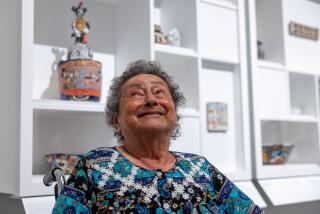Museum Buys Early Painting by El Greco : Art: San Diego Museum of Art also acquires piece by 17th-Century Spanish still-life painter Juan Sanchez Cotan.
- Share via
SAN DIEGO — The San Diego Museum of Art has purchased an early painting on copper by El Greco titled “The Adoration of the Shepherds” and a religious painting on copper titled “St. Sebastian” by the renowned 17th-Century Spanish still-life painter Juan Sanchez Cotan.
Museum director Steven Brezzo said Thursday that the museum paid “in excess of half a million dollars” for the El Greco and “under a hundred thousand” for the Sanchez Cotan. Both paintings were purchased from dealers in New York, according to Nora Desloge, the museum’s curator of European art.
Desloge said the works were paid for with acquisition funds accumulated from endowments sales over the past few years of “minor works” that had long been in museum vaults.
The El Greco, dated 1572-74, has been installed for public view in the museum’s “Mr. and Mrs. Watler Fitch Jr. Memorial Gallery” of Old Master paintings. The Sanchez Cotan, from about 1604, will not be displayed for at least two months because it needs cleaning and reframing.
Both works complement major paintings by the same artists already in the San Diego museum’s collection: El Greco’s “The Penitent St. Peter,” a large portrait of the saint in prayer from 1596-1600, the peak period of the artist’s career, and Sanchez Cotan’s “Quince, Cabbage, Melon and Cucumber,” 1602, a painting that is known as one of the earliest still-life images done in Spain. (Only two other works by Sanchez Cotan are in collections in the United States.)
Desloge said the El Greco has been on the market for at least three years, but the museum took time to consider the purchase.
“I hadn’t thought previously about (purchasing) this sort of small work,” Desloge said; the El Greco measures just 9 1/2 inches by 7 3/8 inches, and the Sanchez Cotan is just 5 inches by 4 inches.
“When two copper works became available, it made them much more sensible for us,” Desloge said, adding that the works will be installed together in a vitrine case.
“This was a chance for us to enrich what we already have,” she continued. “These works relate to two of the most important works in the museum’s collection.”
She also said that both are of the highest quality.
“People often think an important painting is a big painting. But exquisite, marvelous objects are often small.”
The El Greco is a rare and highly prized early work according to art historian William B. Jordan, a leading scholar in Spanish art and one of the organizers of the “El Greco of Toledo” exhibition shown at the National Gallery of Art in Washington and other museums in 1982.
“I like the painting very much, I’ve always loved it,” Jordan said. “That little picture belongs in a collection that has a painting of the type people expect” of El Greco, Jordan said, “like the one at the San Diego museum.”
Jordan said the work was done in Italy by the Greek-born, 16th-Century master best known for his Expressionist religious paintings done in Spain during the late 16th and early 17th centuries. It was likely done in Rome at a time when the artist officially called himself a “miniature” painter, which means that his trade was to do small works and illustrations rather than large portraits and other major religious works. El Greco’s large-scale mature style developed later, particularly after he moved to Toledo, Spain, in 1577.
“Throughout his career, El Greco repeated himself often,” Jordan said, noting at least three other versions of the “Adoration of the Shepherds” known to scholars. The largest is a work belonging to the Duke of Buccleuch in England, which is the same composition but about 4 feet high.
The San Diego work shows hints of El Greco’s mature style. A rich surface of brushwork and El Greco’s luminescent colors already are in evidence.
Copper works by El Greco are very rare, Jordan said, although paintings on copper were common at the time and throughout the 17th and 18th centuries.
“They tend to be extremely prized by collectors because they don’t have to be flattened and relined like paintings on canvas, and they don’t split like paintings on wood. The paint also becomes translucent, the copper gives luminosity to the paint,” Jordan said. “Connoisseurs love them.”
Desloge said Jordan, who works as an independent curator and consultant from Dallas, was the first to recognize the Sanchez Cotan painting as a work by the Spanish master. It was recently sold at auction in New York to the New York dealer who sold the painting to the museum, and at the time was identified only as being by a Flemish master.
Desloge said the museum was aware of the painting at the time, but could not risk buying it until it was confirmed by Jordan and other scholars that it was a Sanchez Cotan.
“The museum is not in the position to take a risk,” she said.
More to Read
The biggest entertainment stories
Get our big stories about Hollywood, film, television, music, arts, culture and more right in your inbox as soon as they publish.
You may occasionally receive promotional content from the Los Angeles Times.










